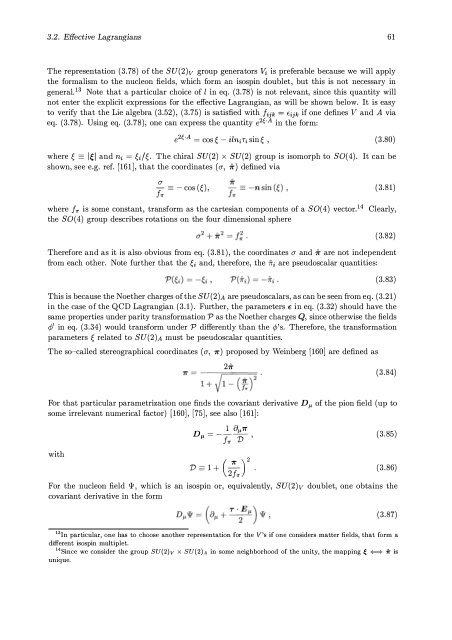The Nucleon-Nucleon Interaction in a Chiral Effective Field Theory
The Nucleon-Nucleon Interaction in a Chiral Effective Field Theory
The Nucleon-Nucleon Interaction in a Chiral Effective Field Theory
Create successful ePaper yourself
Turn your PDF publications into a flip-book with our unique Google optimized e-Paper software.
3.2. <strong>Effective</strong> Lagrangians 61<br />
<strong>The</strong> representation (3.78) of the 8U(2)v group generators Vi is preferable because we will apply<br />
the formalism to the nucleon fields, which form an isosp<strong>in</strong> doublet, but this is not necessary <strong>in</strong><br />
general.13 Note that a particular choice of I <strong>in</strong> eq. (3.78) is not relevant, s<strong>in</strong>ce this quantity will<br />
not enter the explicit expressions for the effective Lagrangian, as will be shown below. It is easy<br />
to verify that the Lie algebra (3.52), (3.75) is satisfied with fijk = Eijk if one def<strong>in</strong>es V and A via<br />
eq. (3.78). Us<strong>in</strong>g eq. (3.78), one can express the quantity e2�.A <strong>in</strong> the form:<br />
cos � - ilnm s<strong>in</strong> � , (3.80)<br />
e2�.A =<br />
where � == lei and ni = �d�. <strong>The</strong> chiral 8U(2) x 8U(2) group is isomorph to 80(4). It can be<br />
shown, see e.g. ref. [161], that the coord<strong>in</strong>ates ( 0', *) def<strong>in</strong>ed via<br />
0'<br />
- == - cos (�),<br />
(3.81)<br />
fn<br />
where fn is some constant, transform as the cartesian components of a 80(4) vector.14 Clearly,<br />
the 80(4) group describes rotations on the four dimensional sphere<br />
(3.82)<br />
<strong>The</strong>refore and as it is also obvious from eq. (3.81), the coord<strong>in</strong>ates 0' and * are not <strong>in</strong>dependent<br />
from each other. Note furt her that the �i and, therefore, the 7ri are pseudoscalar quantities:<br />
(3.83)<br />
This is because the Noether charges of the 8U(2)A are pseudoscalars, as can be seen from eq. (3.21)<br />
<strong>in</strong> the case of the QCD Lagrangian (3.1). Furt her , the parameters € <strong>in</strong> eq. (3.32) should have the<br />
same properties under parity transformation Pas the Noether charges Q, s<strong>in</strong>ce otherwise the fields<br />
cjJ' <strong>in</strong> eq. (3.34) would transform under P differently than the cjJ's. <strong>The</strong>refore, the transformation<br />
parameters � related to 8U(2)A must be pseudoscalar quantities.<br />
<strong>The</strong> so-called stereographical coord<strong>in</strong>ates (0', 'Fr ) proposed by We<strong>in</strong>berg [160] are def<strong>in</strong>ed as<br />
2* (3.84)<br />
Für that particular parametrization one f<strong>in</strong>ds the covariant derivative D p, of the pion field (up to<br />
some irrelevant numerical factor) [160], [75], see also [161]:<br />
D _ -<br />
_ � ßp,'Fr P, fn D<br />
'<br />
(3.85)<br />
with<br />
D == 1 + (�)2 2fn .<br />
(3.86)<br />
For the nucleon field \[I, which is an isosp<strong>in</strong> or, equivalently, 8U(2)v doublet, one obta<strong>in</strong>s the<br />
covariant derivative <strong>in</strong> the form<br />
(3.87)<br />
13 In particular, one has to choose another representation far the V's if one considers matter fields, that form a<br />
different isosp<strong>in</strong> multiplet.<br />
14 S<strong>in</strong>ce we consider the group SU(2)v x SU(2)A <strong>in</strong> some neighborhood of the unity, the mapp<strong>in</strong>g � .;==} ir is<br />
unique.












